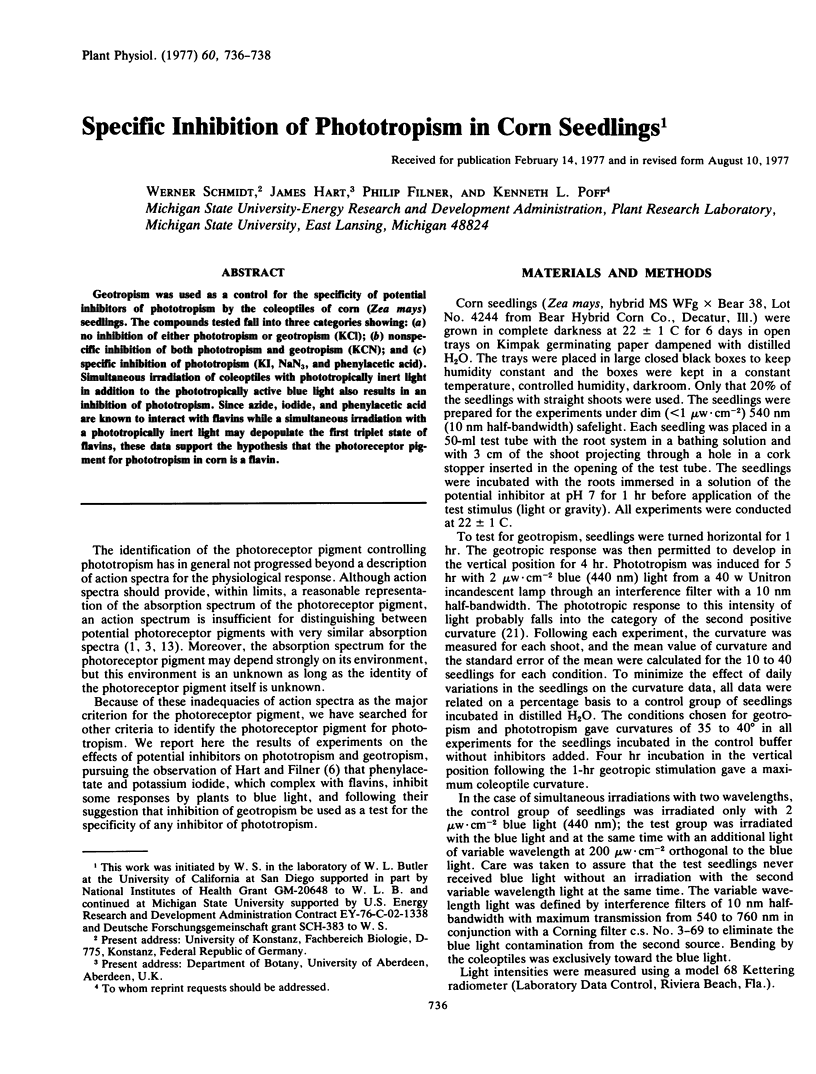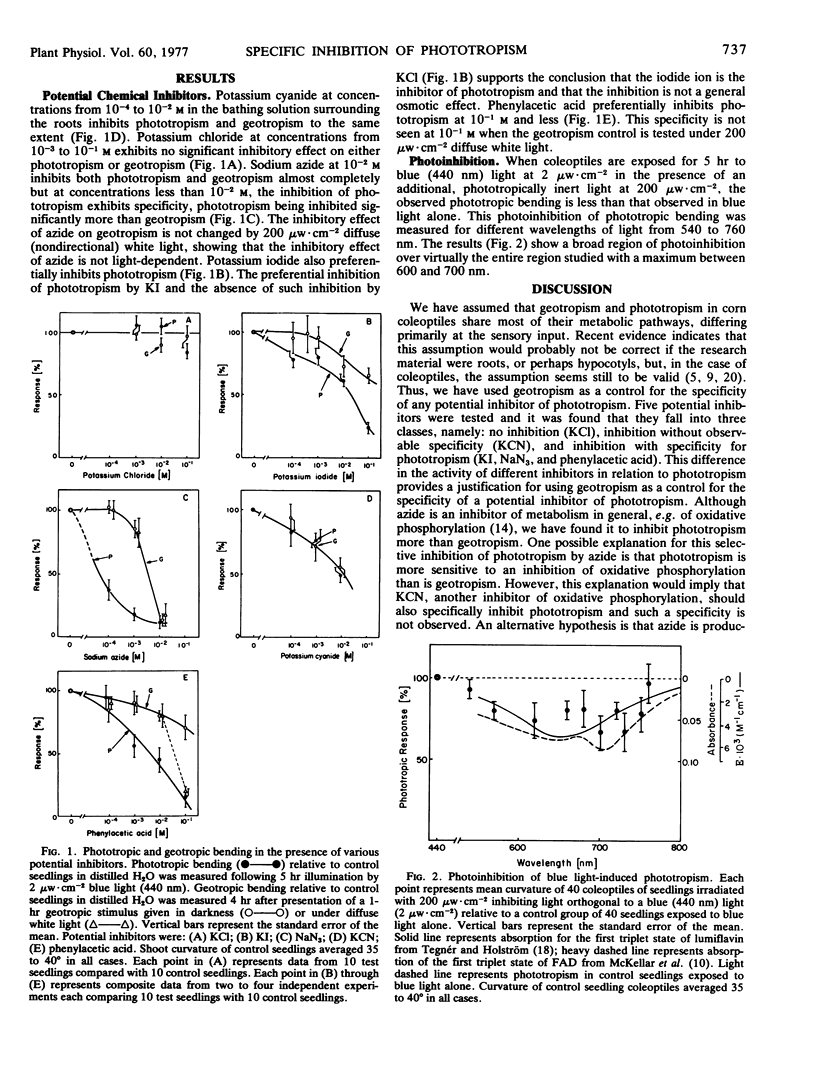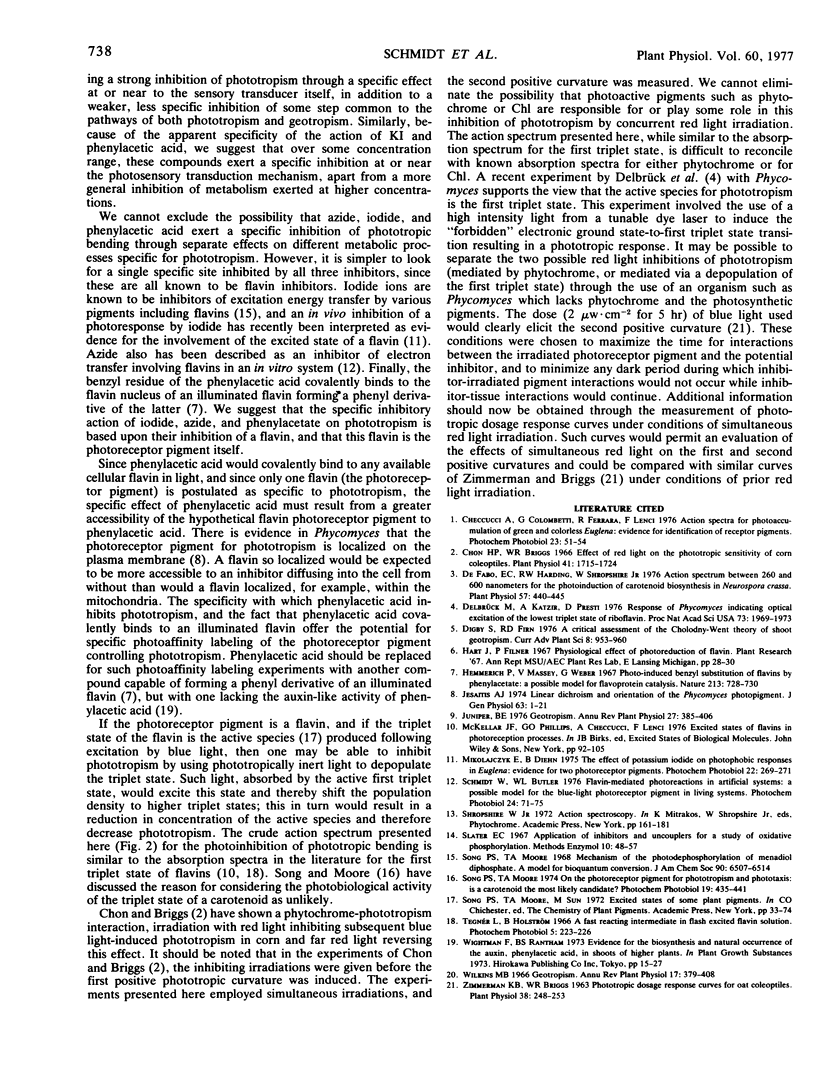Abstract
Geotropism was used as a control for the specificity of potential inhibitors of phototropism by the coleoptiles of corn (Zea mays) seedlings. The compounds tested fall into three categories showing: (a) no inhibition of either phototropism or geotropism (KCl); (b) nonspecific inhibition of both phototropism and geotropism (KCN); and (c) specific inhibition of phototropism (KI, NaN3, and phenylacetic acid). Simultaneous irradiation of coleoptiles with phototropically inert light in addition to the phototropically active blue light also results in an inhibition of phototropism. Since azide, iodide, and phenylacetic acid are known to interact with flavins while a simultaneous irradiation with a phototropically inert light may depopulate the first triplet state of flavins, these data support the hypothesis that the photoreceptor pigment for phototropism in corn is a flavin.
Full text
PDF


Selected References
These references are in PubMed. This may not be the complete list of references from this article.
- Checcucci A., Colombetti G., Ferrara R., Lenci F. Action spectra for photoaccumulation of green and colorless Euglena: evidence for identification of receptor pigments. Photochem Photobiol. 1976 Jan;23(1):51–54. doi: 10.1111/j.1751-1097.1976.tb06770.x. [DOI] [PubMed] [Google Scholar]
- Chon H. P., Briggs W. R. Effect of red light on the phototropic sensitivity of corn coleoptiles. Plant Physiol. 1966 Dec;41(10):1715–1724. doi: 10.1104/pp.41.10.1715. [DOI] [PMC free article] [PubMed] [Google Scholar]
- De Fabo E. C., Harding R. W., Shropshire W. Action Spectrum between 260 and 800 Nanometers for the Photoinduction of Carotenoid Biosynthesis in Neurospora crassa. Plant Physiol. 1976 Mar;57(3):440–445. doi: 10.1104/pp.57.3.440. [DOI] [PMC free article] [PubMed] [Google Scholar]
- Delbrück M., Katzir A., Presti D. Responses of Phycomyces indicating optical excitation of the lowest triplet state of riboflavin. Proc Natl Acad Sci U S A. 1976 Jun;73(6):1969–1973. doi: 10.1073/pnas.73.6.1969. [DOI] [PMC free article] [PubMed] [Google Scholar]
- Hemmerich P., Massey V., Weber G. Photo-induced benzyl substitution of flavins by phenylacetate: a possible model for flavoprotein catalysis. Nature. 1967 Feb 18;213(5077):728–730. doi: 10.1038/213728a0. [DOI] [PubMed] [Google Scholar]
- Mikolajczyk E., Diehn B. The effect of potassium iodide on photophobic responses in Euglena: evidence for two photoreceptor pigments. Photochem Photobiol. 1975 Dec;22(6):269–271. doi: 10.1111/j.1751-1097.1975.tb06748.x. [DOI] [PubMed] [Google Scholar]
- Schmidt W., Butler W. L. Flavin-mediated photoreactions in artificial systems: a possible model for the blue-light photoreceptor pigment in living systems. Photochem Photobiol. 1976 Jul;24(1):71–75. doi: 10.1111/j.1751-1097.1976.tb06799.x. [DOI] [PubMed] [Google Scholar]
- Song P. S., Moore T. A. On the photoreceptor pigment for phototropism and phototaxis: is a carotenoid the most likely candidate? Photochem Photobiol. 1974 Jun;19(6):435–441. doi: 10.1111/j.1751-1097.1974.tb06535.x. [DOI] [PubMed] [Google Scholar]
- Zimmerman B. K., Briggs W. R. Phototropic Dosage-Response Curves for Oat Coleoptiles. Plant Physiol. 1963 May;38(3):248–253. doi: 10.1104/pp.38.3.248. [DOI] [PMC free article] [PubMed] [Google Scholar]


